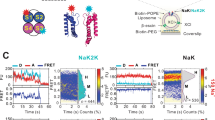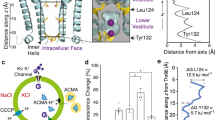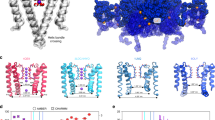Abstract
Potassium channels, a group of specialized membrane proteins, enable K+ ions to flow selectively across cell membranes. Transmembrane K+ currents underlie electrical signalling in neurons and other excitable cells. The atomic structure of a bacterial K+ channel pore has been solved by means of X-ray crystallography. To the extent that the prokaryotic pore is representative of other K+ channels, this landmark achievement has profound implications for our general understanding of K+ channels. But serious doubts have been raised concerning whether the prokaryotic K+ channel pore does actually represent those of eukaryotes. Here we have addressed this fundamental issue by substituting the prokaryotic pore into eukaryotic voltage-gated and inward-rectifier K+ channels. The resulting chimaeras retain the respective functional hallmarks of the eukaryotic channels, which indicates that the ion conduction pore is indeed conserved among K+ channels.
This is a preview of subscription content, access via your institution
Access options
Subscribe to this journal
Receive 51 print issues and online access
$199.00 per year
only $3.90 per issue
Buy this article
- Purchase on Springer Link
- Instant access to full article PDF
Prices may be subject to local taxes which are calculated during checkout






Similar content being viewed by others
References
Tempel, B. L., Papazian, D. M., Schwarz, T. L., Jan, Y. N. & Jan, L. Y. Sequence of a probable potassium channel component encoded at Shaker locus of Drosophila. Science 237, 770–775 (1987).
Pongs, O. et al. Shaker encodes a family of putative potassium channel proteins in the nervous system of Drosophila. EMBO J. 7, 1087–1096 (1988).
Kamb, A., Tseng-Crank, J. & Tanouye, M. A. Multiple products of the Drosophila Shaker gene may contribute to potassium channel diversity. Neuron 1, 421–430 (1988).
Ho, K. et al. Cloning and expression of an inwardly rectifying ATP-regulated potassium channel. Nature 362, 31–38 (1993).
Kubo, Y., Baldwin, T. J., Jan, Y. N. & Jan, L. Y. Primary structure and functional expression of a mouse inward rectifier potassium channel. Nature 362, 127–133 (1993).
Doyle, D. A. et al. The structure of the potassium channel: molecular basis of K+ conduction and selectivity. Science 280, 69–77 (1998).
Schrempf, H. et al. A prokaryotic potassium ion channel with two predicted transmembrane segments from Streptomyces lividans. EMBO J. 14, 5170–5178 (1995).
Minor, D. L. J., Masseling, S. J., Jan, Y. N. & Jan, L. Y. Transmembrane structure of an inwardly rectifying potassium channel. Cell 96, 879–891 (1999).
del Camino, D., Holmgren, M., Liu, Y. & Yellen, G. Blocker protection in the pore of a voltage-gated K+ channel and its structural implications. Nature 403, 321–325 (2000).
Hoshi, T., Zagotta, W. N. & Aldrich, R. W. Biophysical and molecular mechanisms of Shaker potassium channel inactivation. Science 250, 533–538 (1990).
Li-Smerin, Y., Hackos, D. H. & Swartz, K. J. A localized interaction surface for voltage- sensing domains on the pore domain of a K+ channel. Neuron 25, 411–423 (2000).
Schoppa, N. E., McCormack, K., Tanouye, M. A. & Sigworth, F. J. The size of gating charge in wild-type and mutant Shaker potassium channels. Science 255, 1712–1715 (1992).
Garcia, M. L., Garcia-Calvo, M., Hidalgo, P., Lee, A. & MacKinnon, R. Purification and characterization of three inhibitors of voltage-dependent K+ channels from Leiurus quinquestriatus var. hebraeus venom. Biochemistry 33, 6834–6839 (1994).
MacKinnon, R., Cohen, S. L., Kuo, A., Lee, A. & Chait, B. T. Structural conservation in prokaryotic and eukaryotic potassium channels. Science 280, 106–109 (1998).
Hackos, D. H. & Swartz, K. J. Disrupting the cytoplasmic gate in the Shaker K+ channel with mutations in S6. Biophys. J. 80, 182a–183a (2001).
Pardo, L. A. et al. Extracellular K+ specifically modulates a rat brain K+ channel. Proc. Natl Acad. Sci. USA 89, 2466–2470 (1992).
Hoshi, T., Zagotta, W. N. & Aldrich, R. W. Two types of inactivation in Shaker K+ channels: effects of alterations in the carboxy-terminal region. Neuron 7, 547–556 (1991).
Lopez-Barneo, J., Hoshi, T., Heinemann, S. H. & Aldrich, R. W. Effects of external cations and mutations in the pore region on C-type inactivation of Shaker potassium channels. Recept. Channels 1, 61–71 (1993).
Yellen, G., Sodickson, D., Chen, T. Y. & Jurman, M. E. An engineered cysteine in the external mouth of a K+ channel allows inactivation to be modulated by metal binding. Biophys. J. 66, 1068–1075 (1994).
Heginbotham, L., LeMasurier, M., Kolmakova-Partensky, L. & Miller, C. Single Streptomyces lividans K+ channels: Functional asymmetries and sidedness of proton activation. J. Gen. Physiol. 114, 551–560 (1999).
Stanfield, P. R. et al. A single aspartate residue is involved in both intrinsic gating and blockage by Mg2+ of the inward rectifier, IRK1. J. Physiol. (Lond.) 478, 1–6 (1994).
Lopatin, A. N., Makhina, E. N. & Nichols, C. G. Potassium channel block by cytoplasmic polyamines as the mechanism of intrinsic rectification. Nature 372, 366–369 (1994).
Ficker, E., Taglialatela, M., Wible, B. A., Henley, C. M. & Brown, A. M. Spermine and spermidine as gating molecules for inward rectifier K+ channels. Science 266, 1068–1072 (1994).
Fakler, B. et al. Strong voltage-dependent inward rectification of inward rectifier K+ channels is caused by intracellular spermine. Cell 80, 149–154 (1995).
Yang, J., Jan, Y. N. & Jan, L. Y. Control of rectification and permeation by residues in two distinct domains in an inward rectifier K+ channel. Neuron 14, 1047–1054 (1995).
Lu, Z. & MacKinnon, R. Electrostatic tuning of Mg2+ affinity in an inward-rectifier K+ channel. Nature 371, 243–246 (1994).
Wible, B. A., Taglialatela, M., Ficker, E. & Brown, A. M. Gating of inwardly rectifying K+ channels localized to a single negatively charged residue. Nature 371, 246–249 (1994).
Kubo, Y., Reuveny, E., Slesinger, P. A., Jan, Y. N. & Jan, L. Y. Primary structure and functional expression of a rat G-protein-coupled muscarinic potassium channel. Nature 364, 802–806 (1993).
Dascal, N. et al. Atrial G protein-activated K+ channel: expression cloning and molecular properties. Proc. Natl Acad. Sci. USA 90, 10235–10239 (1993).
Krapivinsky, G. et al. The G-protein-gated atrial K+ channel IKACh is a heteromultimer of two inwardly rectifying K+ channel proteins. Nature 374, 135–141 (1995).
Bond, C. T. et al. Cloning and expression of a family of inward rectifier potassium channels. Recept. Channels 2, 183–191 (1994).
Perozo, E., Cortes, D. M. & Cuello, L. G. Structural rearrangements underlying K+-channel activation gating. Science 285, 73–78 (1999).
Huang, C. L., Feng, S. & Hilgemann, D. W. Direct activation of inward rectifier potassium channels by PIP2 and its stabilization by Gβγ. Nature 391, 803–806 (1998).
Lu, Z. & MacKinnon, R. Purification, characterization, and synthesis of an inward-rectifier K+ channel inhibitor from scorpion venom. Biochemistry 36, 6936–6940 (1997).
Taglialatela, M., Ficker, E., Wible, B. A. & Brown, A. M. C-terminus determinants for Mg2+ and polyamine block of the inward rectifier K+ channel IRK1. EMBO J. 14, 5532–5541 (1995).
Li-Smerin, Y. & Swartz, K. J. Gating modifier toxins reveal a conserved structural motif in voltage-gated Ca2+ and K+ channels. Proc. Natl Acad. Sci. USA 95, 8585–8589 (1998).
Liman, E. R., Hess, P., Weaver, F. & Korean, G. Voltage-sensing residues in the S4 region of a mammalian K+ channel. Nature 353, 752–756 (1991).
Papazian, D. M., Timpe, L. C., Jan, Y. N. & Jan, L. Y. Alteration of voltage-dependence of Shaker potassium channel by mutations in the S4 sequence. Nature 349, 305–310 (1991).
Aggarwal, S. K. & MacKinnon, R. Contribution of the S4 segment to gating charge in the Shaker K+ channel. Neuron 16, 1169–1177 (1996).
Seoh, S.-A., Sigg, D., Papazian, D. M. & Benzanilla, F. Voltage-sensing residues in the S2 and S4 segments of the Shaker K+ channel. Neuron 16, 1159–1167 (1996).
Yang, N., George, A. L. J. & Horn, R. Molecular basis of charge movement in voltage-gated sodium channels. Neuron 16, 113–122 (1996).
Larsson, H. P., Baker, O. S., Dhillon, D. S. & Isacoff, E. Y. Transmembrane movement of the shaker K+ channel S4. Neuron 16, 387–397 (1996).
Armstrong, C. M. Interaction of tetraethylammonium ion derivatives with the potassium channels of giant axons. J. Gen. Physiol. 58, 413–437 (1971).
Liu, Y., Holmgren, M., Jurman, M. E. & Yellen, G. Gated access to the pore of a voltage-dependent K+ channel. Neuron 19, 175–184 (1997).
Caprini, M. et al. Structural compatibility between the putative voltage sensor of voltage-gated K+ channels and the prokaryotic KcsA channel. J. Biol. Chem. 276, 21070–21076 (2001).
VanDongen, A. M. J., Frech, G. C., Drewe, J. A., Joho, R. H. & Brown, A. M. Alteration and restoration of K+ channel function by deletions at the N- and C-termini. Neuron 5, 433–443 (1990).
Chen, G.-Q., Cui, C., Mayer, M. L. & Gouaux, E. Functional characterization of a potassium-selective prokaryotic glutamate receptor. Nature 402, 817–821 (1999).
Spassova, M. & Lu, Z. Coupled ion movement underlies rectification in an inward-rectifier K+ channel. J. Gen. Physiol. 112, 211–221 (1998).
Guo, D. & Lu, Z. Pore block versus intrinsic gating in the mechanism of inward rectification in the strongly-rectifying IRK1 channel. J. Gen. Physiol. 116, 561–568 (2000).
Butler, A., Wei, A., Baker, K. & Salkoff, L. A family of putative potassium channel genes in Drosophila. Science 243, 943–947 (1989).
Acknowledgements
We thank P. De Weer for review and discussion of our manuscript; C. M. Armstrong, R. MacKinnon and K. J. Swartz for discussions and suggestions; R. MacKinnon and E. Perozo for KcsA cDNA; K. J. Swartz for Shaker-IR cDNA subcloned in the pGEM–HESS vector; L. Y. Jan for IRK1 cDNA; and J. Yang for IRK1 cDNA subcloned in the pGEM–HESS vector. This study was supported by the National Institute of General Medical Sciences. Z.L. is the recipient of an Independent Scientist Award from the National Heart, Lung and Blood Institute.
Author information
Authors and Affiliations
Corresponding author
Rights and permissions
About this article
Cite this article
Lu, Z., Klem, A. & Ramu, Y. Ion conduction pore is conserved among potassium channels. Nature 413, 809–813 (2001). https://doi.org/10.1038/35101535
Received:
Accepted:
Issue Date:
DOI: https://doi.org/10.1038/35101535
This article is cited by
-
Inactivation of the Kv2.1 channel through electromechanical coupling
Nature (2023)
-
CNG channel structure, function, and gating: a tale of conformational flexibility
Pflügers Archiv - European Journal of Physiology (2021)
-
Two-stage electro–mechanical coupling of a KV channel in voltage-dependent activation
Nature Communications (2020)
-
Voltage-dependent gating in K channels: experimental results and quantitative models
Pflügers Archiv - European Journal of Physiology (2020)
-
Noncanonical mechanism of voltage sensor coupling to pore revealed by tandem dimers of Shaker
Nature Communications (2019)
Comments
By submitting a comment you agree to abide by our Terms and Community Guidelines. If you find something abusive or that does not comply with our terms or guidelines please flag it as inappropriate.



